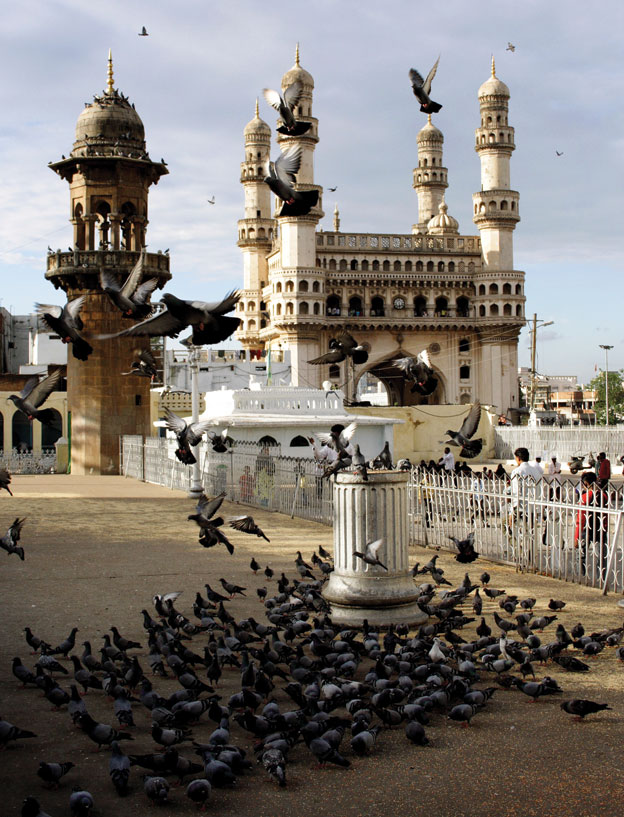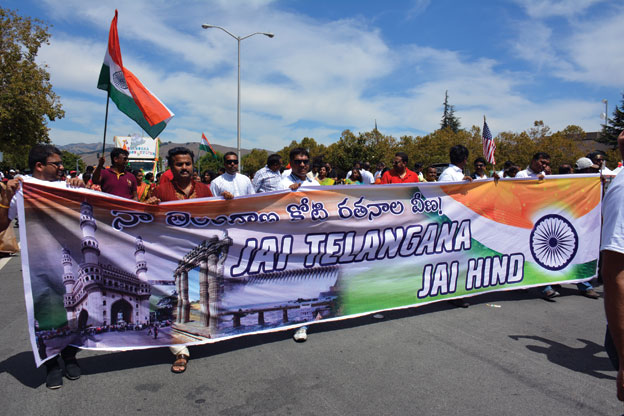POLITICS:
Carving Out Telangana: Reorganizing State Boundaries
On June 30, 2013, the central government agreed to the demands of a 50+-year-old movement for economic and political space for the people of Telangana as a separate state for them from the present Andhra Pradesh, writes Priyanka Bhardwaj.

(Above): The Charminar in Hyderabad, the capital of Andhra Pradesh, and proposed capital of Telangana for the first 10 years.
The 29th state in the Indian Union geographically lies on the Deccan plateau, situated between the Rivers of Krishna and Godavari and sandwiched between the Eastern and Western Ghats.
The mother state of Andhra Pradesh with a population of 85 million is 60,000 square miles in area and comprises of Telangana, the coastal region and Rayalseema, and has Hyderabad as it capital.
But due to ill distribution of resources and development benefits, Telangana remained in abject poverty, the result being the spread of the internal threat of Naxalism, much more when compared to other areas of Andhra Pradesh.
Once Telangana comes into existence, Hyderabad will remain the joint capital for ten years during which Seemandhra (non-Telangana parts of Andhra Pradesh — coastal Andhra and Rayalaseema) will have to appoint or build its own capital.
When the Indian Union became independent in 1947, the state boundaries were largely based on geographical, historical, political and cultural considerations.
The government of India sought to bring all territorial divisions under a central command and with the areas linked in an administrative network and existing in a harmonious, better administered integrated and cohesive whole.
However, in 1956 there was a new call from various regions for reshaping of their state boundaries along linguistic lines and thus were born several Hindi speaking states in central and north India and four big South Indian states for the four major Dravidian speaking populations.
It would be too simplistic to term the states as homogenous entities. These are not true or complete linguistic divisions, as various dialect-speaking large populations remained incorporated within the new states.
Exploration of the history of Telangana and Andhra Pradesh reveals that the state of Andhra first came into being in 1953.
Then in 1956 Telangana was added to this state, with linguistic similarities despite cultural and historic dissimilarities, to make up what is today known as the state of Andhra Pradesh.
The goal was administrative convenience and resolution of grave water conflicts, but this formation accrued collateral benefits to the Congress that went on to score well electorally due to the emergent ‘Reddy’ caste.

(Above): Supporters of Telangana march at the FIA Festival of India Parade in Fremont, Calif., Aug. 18. [Photo: Amar D. Gupta | Siliconeer]
On the other hand, many political leaders from Telangana pandered to local disenchantment that stemmed from unequal opportunities in jobs, land, benefits and water, and harped on retrieving Telangana for its people.
The agitation for separation became particularly acute with the death of chief minister Y.S. Rajashekhara Reddy in 2009, and then on June 30, 2013 the center, led by Congress took the historic decision, more so aiming at the 2014 general elections.
This has taken air out of the wings of certain political parties like the Telengana Rashtra Samithi and Bharatiya Janata Party who had promised Telangana in their election manifesto.
But the road to victory as well as reorganization of the state is certainly not smooth and a lot will depend on political will and orientation.
The Congress had been wresting majority seats in Andhra Pradesh since 2004, is expected to face severe dent in their Reddy vote bank once Telengana is in place.
Due to the disadvantageous position accruing from changes in caste demography, many local Congress leaders had vehemently opposed the decision and it is not yet clear what may be the result of this resentment.
The formation of Telangana is expected to raise the percentage of Muslims and tribals in Andhra Pradesh. This means promulgating more programs to co-opt these populations in future policies to win their political mandate.
To win over the Urdu-speaking population, the Telangana Rashtra Samithi has already announced making Urdu an official language of the state if voted to rule.
Then again, with the primitive tribe of Madigas in Telangana becoming more demanding for better chances at education and obtaining government jobs besides more political empowerment, there will be a need for class reorganization.
Already the prospect of loss of Hyderabad as state capital and the coastal areas has not gone down well with the people of Rayalseema, and in anticipation of clashes between pro-Telangana activists and those opposed to it, the government of India has deployed an additional 1,500 paramilitary personnel while the Andhra Pradesh state assembly works out power and water distributions.
The immediate fallout of the June announcement has been a renewal in demand for a greater Rayalaseema on the coastal areas of Andhra Pradesh and with Kurnool as capital, and for Gorkhaland and Bodoland to be etched out of West Bengal and Assam by Gorkha and Bodo activists respectively.
So, it emerges that if contouring of states on linguistic grounds enabled a strong administrative network, a linguistic homogeneity also could not ensure foolproof regional cohesion.
The emergence of new states presents complexities that will have to be managed between the center and the new state, and between the new state and neighboring ones.
In order to fulfill aspirations while maintaining unity, the center will have to take on further responsibilities to facilitate de-centralization and democratization of development and equal distribution of power and justice among the marginal, poor or disadvantaged groups in the new states who want to come at par with the traditional elites.
|